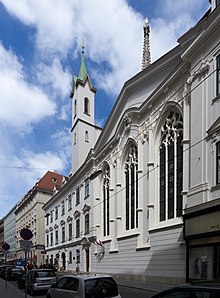Treasury of the Teutonic Order
The church is incorporated in the Deutschordenshaus, the seat of the Order. Next to the cobbled inner courtyard is the Schatzkammer (the Treasure Room), a real ecclesiastical treasure trove that has been turned into a museum, consisting of five rooms on the second floor. The different collections have been built by successive Grand Masters during eight centuries. They constitute one of the oldest treasure collections in Vienna, covering the Gothic, Renaissance, and Baroque periods. The real start of the Schatzkammer can be dated to 1525 when the Grand Master Albert of Prussia converted to Lutheranism and declared the collections his private property. The museum was reopened on 22 April 2006 after an extensive renovation.
The first room displays Gothic coins, medals, seals, crosses, and a 13th-century coronation ring.
The second room shows chalices with silvery filigree, but also some more extravagant features. There is a salt-cellar tree, made from red coral, hung with sharks' teeth. In medieval times these were thought to be fossilized adders' tongues, able to detect poisoned food. Also remarkable are a number of vessels made of coconut shells, such one from Goa with silver mountings and another one in chinoiserie style. Also notable is a silver chain (c. 1500) for the sword carried by the members of the Order. It carries a hanger depicting the Madonna and Child and the insignia of the Order. A precious table clock is adorned with garnets and turquoise and surrounded with a garland of gilded leaves.
The other rooms contain a collection of oriental arms such as a Sumatran kris with a wavy blade and a rhino horn handle, carved in the shape of Buddha with precious stones. Another valuable piece of the collection is the charter by Pope Gregory IX from 1235, declaring Elisabeth of Thuringia a saint. Finally, there are several Gothic paintings and a Carinthian woodcarving of Saint George and the Dragon .
The treasury is open on Tuesdays, Thursdays and Saturdays 10am-12noon, Wednesdays and Fridays 3-5pm.
Preceptory (Deutschordenshaus) in 1733 (Drawing of S. Kleiner).
Winged triptych made in part by Jan van Wavere in 1520.
Capture of the Lord (detail of triptych)
Burial and resurrection of the Lord (detail of triptych)
Coronation of Saint Elisabeth of Thüringen by the Virgin Mary and Christ, together with
Saint George and
Saint Helena (
Tobias Pock, 1667).
This page is based on this
Wikipedia article Text is available under the
CC BY-SA 4.0 license; additional terms may apply.
Images, videos and audio are available under their respective licenses.






